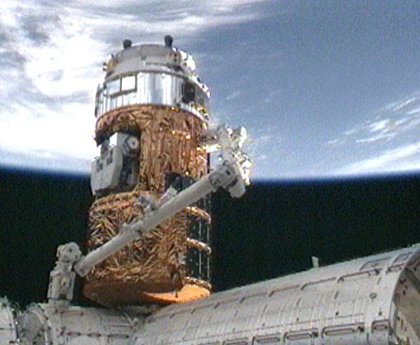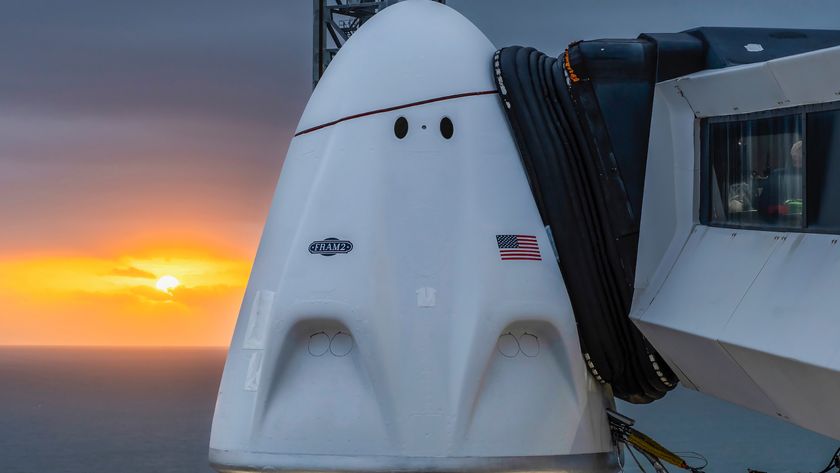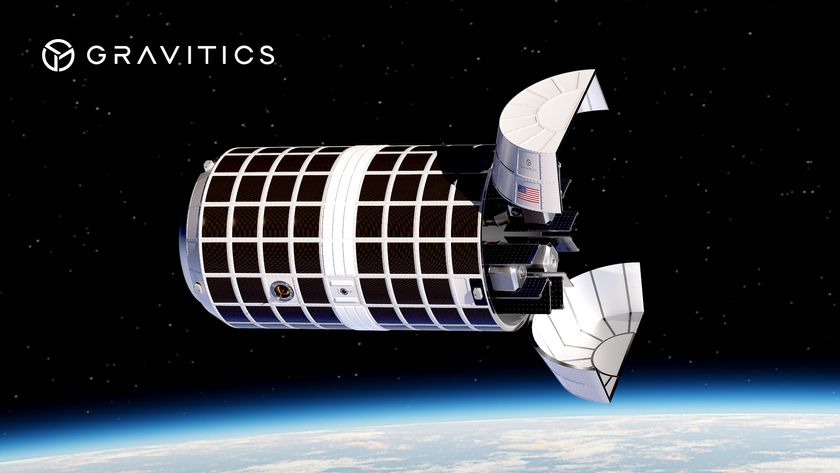Space Station Crew Welcomes Japan's First Cargo Ship

This story was updated at 6:37 p.m. EDT.
Japan?sfirst-ever space cargo ship arrived at the International Space StationThursday to end a flawless maiden voyage to the orbiting lab.
Thegleaming space freighter, dubbed the H-2Transfer Vehicle 1 (HTV-1), approached the space station from below after aweek-long chase so astronaut Nicole Stott could pluck it from orbit using theoutpost?s robotic arm as both spacecraft flew 225 miles (365 km) above westernRomania.
Stott andher crewmates marveled at the new spacecraft as they watched it draw near throughstation windows. She described the 33-foot (10-meter) freighter looked like a ?very shiny,gold? spaceship.
?It justlooks fantastic,? Stott radioed Mission Control. ?We?re going to get somepictures and some video, full coverage of this.?
Stott hadjust 99 seconds to grab onto the HTV-1 spacecraft with the station?s roboticarm when it was 30 feet (9 meters) away. But the maneuver went smoothly and applause erupted from NASA?s Mission Control in Houston. The station?ssix-person crew toasted the freighter?s arrival with a drink of recycled water.
?We had anamazing time doing this, we?re so happy to have this beautiful vehicle here,?Stott said after grabbing HTV-1 at 3:47 p.m. EDT (1947 GMT). ?We look very[much] forward to going in tomorrow and finding all the supplies that I?m sureyou?ve stored there for us.?
Get the Space.com Newsletter
Breaking space news, the latest updates on rocket launches, skywatching events and more!
Japan?sfirst space freighter
Japan?sHTV spacecraft is the latest in a fleet of unmanned international cargoships to deliver supplies and hardware to the space station. It joinsRussia?s Progress freighters, which make routine trips to the station, and theEuropean Automated Transfer Vehicle that debuted last year. Steady cargodeliveries by the various craft will be especially vital to support thestation?s six-person crews once NASA retires its space shuttle fleet in thenext year or so.
?After thespace shuttle starts to fade away, we will take over responsibility to bringstuff up to the space station,? said Japanese astronaut Soichi Noguchi, who is dueto launch to the station in December, in a press conference just before HTV-1 arrived. ?We're reallylooking forward to the success of this mission.?
Built forthe Japan Aerospace Exploration Agency (JAXA), the HTV spacecraft is about aslong as a bus, 14 feet (4.4 meters) wide and covered in solar panels attachedto its cylindrical hull. It is capable of hauling up to six tons of cargo tothe space station, but HTV-1 is carrying about five tons for its maiden flight.
Japan spentabout $680 million since 1997 to develop the spacecraft, JAXA officials said.HTV-1, they added, cost about $220 million.
Thespacecraft will stay linked to the station until about Nov. 1, when it will bejettisoned and commanded to intentionally destroy itself by burning up in theEarth?s atmosphere over the Pacific Ocean.
InsideHTV-1
The HTV isa versatile cargo ship that - unlike Russian and European vehicles - candeliver equipment for both the inside and outside of the space station. It hasa giant sliding drawer in one side that carries experiments and hardware thatcan be retrieved by the station?s robotic arm.
Twoexperiments, one from NASA and the other from JAXA, are stored on HTV-1 andwill be retrieved next week by the station crew and attached to the externalscience porch on Japan?s $1 billion Kibo laboratory.
Food, laptopcomputers and other supplies make up the bulk of the internal cargo stowed inthe pressurized section that station astronauts can access through an entryhatch at one end, mission managers said.
JAXAlaunched the HTV-1 cargo ship in the predawn hours of Sept. 11 Japan StandardTime, though it was still afternoon on Sept. 10 at NASA's station MissionControl Center in Houston. The space freighter lifted off atop the newH-2B rocket, which also performed flawlessly, from the Tanegashima SpaceCenter in southern Japan.
Historictest flight
The HTV-1?sarrival was more than a test flight for Japan. It also demonstrated the captureof free-flying spacecraft using the station?s robotic arm, a talent NASA willneed to grab commercial cargo ships built by the American companies SpaceExploration Technologies and Orbital Sciences Corp.
Stott, whorepresents NASA, said Japan?s HTV spacecraft is a symbol of cooperation amongthe 16 different countries working to build the $100 billion space station. Stott,an American, and Belgian astronaut Frank De Winne caught the Japanesespacecraft using the station?s Canadian-built robotic arm. Canadian astronaut RobertThirsk then used the arm to gingerly attach the cargo ship to anEarth-facing berth on the outpost?s aptly named Harmony module at 6:26 p.m. EDT (2226 GMT).
The stationis currently home to two Americans, two Russians, and one astronaut each fromthe Canadian and European space agencies.
?It?spretty cool, isn?t it?? Stott told SPACE.com before leaving Earth last month.?I think it?s really incredible. It speaks to what this program has reallybeen all about?Plain and simple, it is an international activity.?
- Video - Japan's Spaceship Dreams: Part 1, Part 2
- Video - Inside Japan's New H-2B Rocket
- Video - Maiden Flight of Japan's Space Freighter
Join our Space Forums to keep talking space on the latest missions, night sky and more! And if you have a news tip, correction or comment, let us know at: community@space.com.

Tariq is the Editor-in-Chief of Space.com and joined the team in 2001, first as an intern and staff writer, and later as an editor. He covers human spaceflight, exploration and space science, as well as skywatching and entertainment. He became Space.com's Managing Editor in 2009 and Editor-in-Chief in 2019. Before joining Space.com, Tariq was a staff reporter for The Los Angeles Times covering education and city beats in La Habra, Fullerton and Huntington Beach. In October 2022, Tariq received the Harry Kolcum Award for excellence in space reporting from the National Space Club Florida Committee. He is also an Eagle Scout (yes, he has the Space Exploration merit badge) and went to Space Camp four times as a kid and a fifth time as an adult. He has journalism degrees from the University of Southern California and New York University. You can find Tariq at Space.com and as the co-host to the This Week In Space podcast with space historian Rod Pyle on the TWiT network. To see his latest project, you can follow Tariq on Twitter @tariqjmalik.











